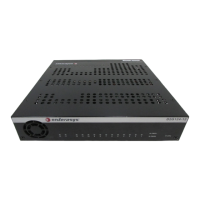show lacp
D-Series CLI Reference 4-37
Parameters
Defaults
Ifport‐stringisnotspecified,linkaggregationinformationforallLAGswillbedisplayed.
Mode
Switchcommand,read‐only.
Usage
EachD‐Seriesmoduleprovides6virtuallinkaggregatorports,whicharedesignatedintheCLIas
lag.0.1throughlag.0.6.Onceunderlyingphysicalports(thatis,
ge.x.x)areassociatedwithan
aggregatorport,theresultingaggregationwillberepresentedasoneLinkAggregationGroup
(LAG)withalag.x.xportdesignation.
Example
Thisexampleshowshowtodisplaylacpinformationforlag.0.1.Thefollowingtabledescribesthe
outputfields.
D2(su)->show lacp lag.0.1
Global Link Aggregation state: enabled
Single Port LAGs: disabled
Aggregator: lag.0.1
Actor Partner
System Identifier: 00:01:F4:5F:1E:20 00:11:88:11:74:F9
System Priority: 32768 32768
Admin Key: 32768
Oper Key: 32768 0
Attached Ports: ge.1.1
ge.1.3
Table 4‐16providesanexplanationofthecommandoutput.
port‐string (Optional)DisplaysLACPinformationforspecificLAGport(s).Valid
portdesignationsarelag.0.1‐6.
Table 4-16 show lacp Output Details
Output Field What It Displays...
Global Link
Aggregation state
Shows if LACP is enabled or disabled on the switch.
Single Port LAGs Displays if the single port LAG feature has been enabled on the switch. See “set lacp
singleportlag” on page 4-41 for more about single port LAG.
Aggregator LAG port designation. Each D-Series module provides 6 virtual link aggregator ports,
which are designated in the CLI as lag.0.1 through lag.0.6. Once underlying physical
ports (for example, ge.x.x) are associated with an aggregator port, the resulting Link
Aggregation Group (LAG) is represented with a lag.x.x port designation.
Actor Local device participating in LACP negotiation.
Partner Remote device participating in LACP negotiation.
System Identifier MAC addresses for actor and partner.
System Priority System priority value which determines aggregation precedence. Only one LACP
system priority can be set on a D-Series device, using either the set lacp asyspri
command (page 4-38), or the set port lacp command (page 4-44).

